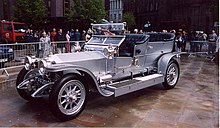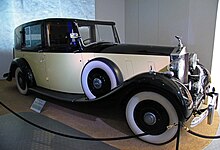Barker & Company (Coachbuilders) Ltd.
| Barker & Company | |
|---|---|
| legal form | Limited Company |
| founding | 1710 |
| resolution | 1938 |
| Reason for dissolution | insolvency |
| Seat | London , UK |
| Branch | Body shop |
Barker & Company (Coachbuilders) Ltd. ( Barker for short ) was a British wheelwright who initially manufactured carriages and, in the 20th century, individual bodies for luxury automobiles. Barker was at times a supplier to the British court and was one of the country's finest car body manufacturers. There was a special relationship with Rolls-Royce , whose preferred body manufacturer Barker was considered until the 1930s. After a bankruptcy in 1938, the name Barker was temporarily used by the previous competitor Hooper .
background
Up until the middle of the 20th century, it was common practice in automobile construction to produce the chassis and the body separately. The automobile manufacturers initially limited themselves to producing roadworthy chassis , consisting of the frame, suspension and often the engine, while the superstructures were designed and manufactured by independent bodywork companies. This separation remained common, especially among upper-class automobile manufacturers, until the Second World War. In all countries with independent automobile production there were numerous body construction companies that offered partly standardized, partly individual and stylistically tailored vehicle bodies. Some of these companies had a tradition of several hundred years; they usually had their roots in coach construction, and more rarely in the construction of railroad cars. One of these established body manufacturers was Barker & Company.
Company history
Barker was founded in 1710 by an officer in the Royal Guard. In the 18th and 19th centuries, Barker manufactured high-quality carriages for transporting people. The company already enjoyed a high level of prestige during this period.
Starting in 1905, the company, initially based in Covent Garden and later in the Shepherd's Bush district , produced car bodies. One of Barker's first designs was for a Henry Royce chassis . Even before Royce founded Rolls-Royce Ltd. together with the car dealer Charles Stewart Rolls . founded, he recommended that his customers prefer to have Barker clad the Royce chassis. Barker's superstructures were considered to be of high quality and stylish. Some of Barker's structures achieved international fame. This includes the version of a Rolls-Royce 40/50 from 1907 called Semi-Roi des Belges , the outer sheet metal parts of which gleamed silver. Because of its special appearance, this model was nicknamed Silver Ghost (silver ghost). Rolls-Royce soon adopted the name for the entire series. In the following decades, Barker also clad chassis from Bentley , Daimler , Packard and other upper-class manufacturers; the relationship with Rolls-Royce remained of particular importance. Up until 1937 there was at least one Rolls-Royce with a special body on every Barker's exhibition stand.
Barker's competitors in the aftermath of World War I were Hooper and Park Ward ; With the exception of the much smaller company Rippon Bros. , most of the other British bodywork manufacturers did not reach the level of these three in terms of quality or style.
In the 1930s, however, Rolls-Royce increasingly moved away from Barker. The reason for this was, on the one hand, technical deficits, which became noticeable from around 1932: Barker's superstructures were both heavy and unstable at this time. On the other hand, Barker was not prepared to adapt its production processes to the requirements of Rolls-Royce: Barker stuck to the working methods from the time before the First World War. When Rolls-Royce tried out new production techniques in the 1930s, the company did not turn to Barker, but to competitor Park Ward, whom Rolls-Royce considered more innovative and flexible. Finally, Rolls-Royce no longer specifically recommended Barker to its customers. As a result, orders for Barker fell significantly. The company went bankrupt in 1938 and went into bankruptcy administration.
Barker's competitor Hooper bought the naming rights from the bankruptcy estate. The Barker name was not reactivated before the outbreak of World War II . During the war, Hooper was taken over by the Birmingham Small Arms Company (BSA), which also included Rolls-Royce competitor Daimler and the long-established automobile manufacturer Lanchester . As a result of this takeover, a revival of Barker's relationship with Rolls-Royce was impossible after the end of the war. Until 1954 there were still bodies for Daimler that were ascribed to Barker - including the standard bodies for the Daimler Regency and special bodies for the DB18 -; in fact they came from Daimler's own work. The attempt to equip the Lanchester LD10 in larger series with bodies known as Barkers failed in 1953. Instead, the superstructures of the LD10 were predominantly obtained from Briggs .
The Goldfinger Phantom III
One of Barker's most famous creations is a Rolls-Royce Phantom III Sedanca de Ville , which was used in the 1964 movie James Bond 007 - Goldfinger . In the film he is driven by Bond's opponent Auric Goldfinger ( Gert Fröbe ) and, following the dramaturgy of the film, allegedly has a body made of pure gold. In this way Goldfinger operated the smuggling of precious metals.
Barker designed the car with chassis number 3BU168 in 1937 as a commissioned work for Lord Fairhaven. The design took up a classic basic line with a free driver and closed passenger compartment ("Sedanca"), which Barker had already implemented several times in the past for the Phantom III chassis. Contrary to the claims made in the movie, the body is made of sheet steel, which was not changed even when it was used as a film prop.
The car still exists. It is shown repeatedly at exhibitions and in museums.
literature
Nick Walker: A – Z of British Coachbuilders 1919–1960 . Shebbear 2007 (Herridge & Sons Ltd.) ISBN 978-0-9549981-6-5 .
Web links
Individual evidence
- ↑ History Barkers on the website www.coachbuild.com (accessed on 25 June 2015).
- ^ A b c d e Nick Walker: A – Z of British Coachbuilders 1919–1960 . Shebbear 2007 (Herridge & Sons Ltd.) ISBN 978-0-9549981-6-5 , pp. 77 f.
- ↑ Rippon Bros., for example, was founded in 1555 and existed until 1970.
- ↑ Detailed description of the Barker Rolls-Royce 40 / 50HP Silver Ghost Phaeton on the website www.coachbuild.com (accessed on June 25, 2015).
- ↑ Dennis Adler, Jay Leno: Packard . Motorbooks International, 2004, ISBN 9780760319284 , p. 100.
- ^ Walker, AZ of British Coachbuilders 1919-1960, p. 168: "luxurious and graceful".
- ^ Brian Long: Daimler & Lanchester. A Century of Motor History , Longford International Publications, 1995, ISBN 1899154019 , p. 216.
- ↑ Description of the Rolls-Royce Phantom III Barker Sedanca on the website www.imcdb.org (accessed on June 25, 2015).
- ↑ Description of the Rolls-Royce Phantom III Barker Sedanca on the website www.jamesbondlifestyle.com (accessed on June 25, 2015).




